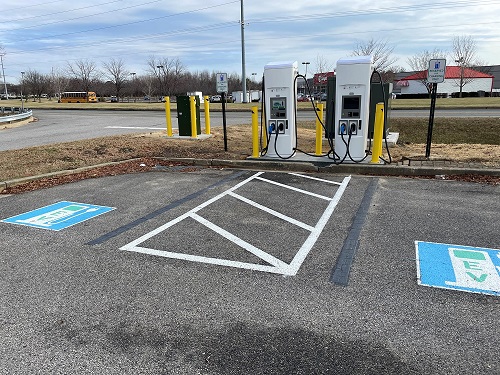The Maryland Department of Transportation is rolling out a new tool to help local governments and agencies dip into $2.5 billion in federal grants to build an electric vehicle or EV charging network.
[Above photo by the Maryland DOT]
The EV Charger Siting Tool is a map-based website that helps the user select those communities and charging sites in Maryland that have the best chance of securing grants under Federal Highway Administration’s Charging and Fueling Infrastructure or CFI discretionary grant program, funded by the $1.2 trillion Infrastructure Investment and Jobs Act or IIJA enacted in November 2021.
The tool consolidates geographic data on existing chargers, registered EV users, disadvantaged communities, alternative fuel corridors, and “marginalized and underserved communities targeted for investment to address climate change and clean energy needs,” the Maryland DOT noted.
“Helping our partners across the state secure federal funding for EV projects is part of our leadership role and this tool is just one facet of our strategy to share knowledge, expertise and experience to make the most of those opportunities,” added Maryland DOT Secretary Paul Wiedefeld in a statement.
[Editor’s note: A recent American Association of State Highway and Transportation Officials video of a knowledge session held at its 2022 Annual Meeting featured panelists from the Michigan, Pennsylvania, and Florida DOTs discussing their respective plans for National Electric Vehicle Infrastructure or NEVI program funds.]
By typing any Maryland address into the tool and selecting from a criteria menu, planners can see which factors in those communities and sites can best help their application. The agency pointed out that June 13 is the deadline for CFI grant applications.
The first round of funding will make $700 million available from fiscal years 2022 and 2023, with a total of $2.5 billion in funding available over the next five years, according to FHWA. The Maryland DOT also has set up a federal grants page on its website to give its partners across the state a good overview of other federal grant opportunities.
Maryland DOT’s Wiedefeld added that his state expects to see “tremendous growth and investment as more and more EVs come into the marketplace.”
Brian Booher, a senior planning specialist at the Montgomery County Department of Environmental Protection, said the Maryland DOT is “always ready to help partners at the local level with grant applications. And the sharing of information – like the data in [the] new Electric Vehicle Charger Siting Tool – is invaluable as we work to benefit our communities and the entire state.”
Maryland has a goal of having 300,000 registered electric vehicles in the state by 2025 and, as of April 2023, there were 70,000 registered EVs in Maryland.
Other state departments of transportation are also working on ways to boost the development of EV charging networks in their respective areas.
For example, from a broad perspective, the North Carolina Department of Transportation recently released the finalized version of its North Carolina Clean Transportation Plan, outlining a roadmap to continue growing the state’s clean energy economy while reducing greenhouse gas or GHG emissions and investing in cleaner and more accessible transportation options for state residents.
The NCDOT said it worked with more than 220 stakeholders for more than a year to develop this draft plan – mandated by Governor Roy Cooper (D) via Executive Order 246 issued January 2022 – which explores strategies to advance clean transportation investments and workforce development statewide.
In a more targeted fashion, the Oregon Department of Transportation recently introduced a rebate plan for state residents living in multifamily homes as well as motorists near public parking areas to spur access to EV charging stations.
The Oregon DOT said the rebate offered by its new Community Charging Rebates Program will range from $4,250 to $5,500 per charging port or up to 75 percent of eligible project costs, whichever is less, to help lower the cost of buying, installing, and maintaining Level 2 and Level 1 EV charging stations.

